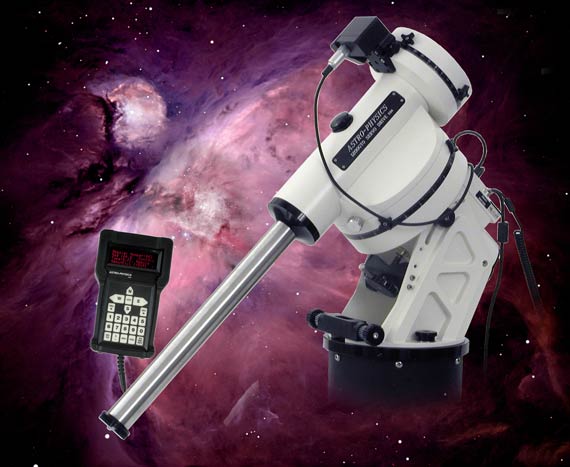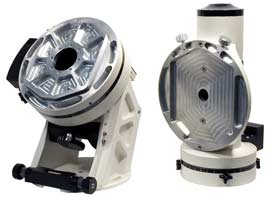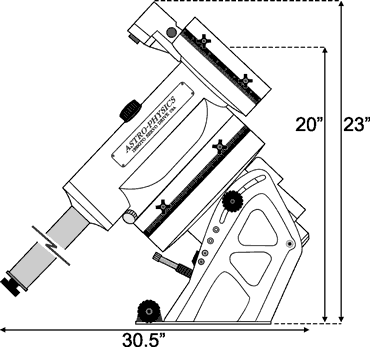ASTRO-PHYSICS
1200GTO German Equatorial Mount (1200GTO)
with GTOCP3 Control Box
Includes GTO Keypad and CDs with
PulseGuide and PEMPro (full version) software

ASTRO-PHYSICS
1200GTO German Equatorial Mount (1200GTO)
with GTOCP3 Control Box
Includes GTO Keypad and CDs with
PulseGuide and PEMPro (full version) software

The 1200GTO German Equatorial Mount with the GTOCP3 Control Box is no longer available to purchase. The information below is provided for present owners and those who are curious about its history. If you are interested in some of the earlier models, check out this Brief History of the 1200 German Equatorial.
Why a 1200GTO?
With the advent of the CCD camera, amateurs are exploring the skies to an ever increasing level of precision, easily exceeding the image quality of large observatories using film techniques decades ago. This new level puts a higher demand on the precision of the equatorial mounting. Many of the finest imagers today have been using our GTO mounts as a solid platform for a wide variety of instruments.
Since its introduction in 1998, the 1200GTO has gained a reputation for both tracking and pointing accuracy, essential to casual visual observation as well as advanced imaging. Quite a few 1200GTO and 900GTO (smaller cousin) mounts can be found at Mount Pinos in California, favorite observing site of many advanced photographers and imagers. You will find them at star parties and in observatories throughout the world.
These mounts are truly a marvel of engineering - maximum strength and rigidity with minimum weight. Our CNC lathes and mills carve out the excess material in both axes of the 1200 and 900 German Equatorials while retaining a heavily ribbed structure for internal strength and rigidity. A unique dovetail was machined into the mating surfaces of the R.A. and Dec axes. This feature allows quick and easy assembly in the field without any tools.
Over the years, a number of improvements have been incorporated into the design of the 1200GTO, among these are smoother azimuth adjusters; increased height of the polar forks to allow more room for your hand when making altitude adjustments; rounded profile of the base to prevent cords from catching; improved gear profiles in the motor gearbox for quieter operation and reduced backlash; motor bracket with built-in spring-action to keep the worms loaded at the proper setting; verifiable worm gear accuracy of 5 arc seconds or less; internal changes to improve overall accuracy; several pier adapter options; updated GTOCP3 control box with additional capability; updated keypad with larger memory capacity and LED fiber optic backlit panel; included PulseGuide and PEMPro software as described below. Each time we begin a production run, we ask ourselves what improvements we can make to improve the accuracy and functionality of the 1200GTO. As a result, the 1200GTO has evolved over the years to meet the needs of the advanced imager or visual observer.
The 1200 equatorial is equally at home in a permanent observatory or as a portable mounting for remote star parties thanks to the ease with which the two axes come apart. You CAN have it all. This is the perfect mount for a large refractor, Newtonian, Cassegrain or astrograph. Telescopes commonly used include Astro-Physics 155-206 mm refractors, 12-14" Schmidt-Cassegrains and 10-16" Ritchey-Chretiens and other instruments of similar size.
The 1200GTO mount is built from the ground up to be a precision imaging platform while still remaining totally user friendly. Consider these advantages and features:
Versatility
| Portable. Extremely solid, rugged, high payload mount, yet the equatorial head comes apart in two reasonably light-weight components for hassle-free field setup. No tools needed to assemble the mount in the field. Operate with 12V battery. You can take it to the darkest skies and power it with a commonly available 12V battery. In the observatory, we suggest a minimum 5 amp filtered, regulated power supply like our 13.8V, 5-amp Power Supply (PS13V5A). For a heavy payload in cold conditions, we offer a 15V, 12-amp power supply (PS15V12AC). Clutches and setting circles. Allow manual operation if power is not available. |
 |
| The 1200GTO’s ability to continue tracking when past the meridian is an absolute winner for me. It avoids meridian flips (=imaging time) and reduces the need for expensive rotators. Jan Rek. More… |
| . . . I love the ability to place the OTA on the "wrong side" of the mount when starting an imaging session ("premature meridian flip") and which I have used extensively. This feature is pure INGENUITY! Anthony Ayiomamitis., More… |
If your computer does not have serial port inputs, there are many USB to serial port adapters available on the market. Serial to USB connectivity has been simplified by the addition of Keyspan Serial-to-USB devices to our product line. Please review the products on this page to determine which one will work best for your set-up.
| I love my mount! And, it works just great in an automated setup! In fact, it's just waiting for ACP to start imaging once it gets a bit darker! James McMillan. More… |
Precise Mechanical Fabrication.
Highly accurate mechanics.| … did some autoguide testing and the results were very good - what strikes me was now smooth the PE was. James Providakes. More… |
Mechanical Features
| Construction | All CNC machined aluminum bar stock, stainless steel, brass; stainless steel fasteners |
| Finishing and Assembly | Every part is hand-finished and inspected. All assembly is done by hand, by highly skilled mount assembly staff. |
| Worm wheel - R.A. | 10.3" (262 mm), 225 tooth aluminum |
| Worm wheel - Dec. | 7.2" (183 mm), 225 tooth aluminum |
| Worm gear - R.A. | Brass, 1.210" (30.7 mm) diameter |
| Worm gear - Dec. | Brass, 0.710" (18 mm) diameter |
| Thrust Bearing - R.A. | 9.5" (241 mm) diameter |
| Thrust bearing - Dec. | 6.5" (165 mm) diameter |
| Axis shaft - R.A. | 3.35" (85 mm) diameter |
| Axis shaft - Dec. | 2.36" (60 mm) diameter |
| Shaft axis bearings - R.A./Dec. | Each shaft is supported by 5 bearing elements, two preloaded ball bearings and 3 sets of massive thrust bearings |
| Latitude range | 22 to 69 degrees with or without the polar scope attached. 0-22 or 69-90 degrees when using Hi-Lo Latitude Wedge (1200WDG or 1200WDGA) |
| Azimuth adjustment | Approximately 14 degrees (+/- 7 degrees from center) |
| Setting circle - R.A. | 4-minute increments, pointer, engraved both Northern/Southern, Porter Slip Ring |
| Setting circle - Dec. | 1 degree increments, pointer, engraved, Porter Slip Ring |
| Counterweight shaft | 1.875" (48 mm) diameter x 19.5" (495 mm) long [18.5" (470 mm) useable length], incl. large machined safety stop knob. Optional 9" (229 mm) shaft extension available. |
| Weight of mount | Total: 95 lb. (43.2 kg) R.A. axis/polar fork: 50 lb. (22.7 kg) Dec. axis: 31 lb. (14.1 kg) Counterweight shaft: 14 lb. (6.4 kg) |
| Capacity | Approximately 140 lb. (63.6 kg) scope and accessories (not including counterweights), depending on length. Recommended for: Astro-Physics and similar fast refractors up to our 206 mm f8 Starfire EDF, 16" Cassegrains and Ritchey-Chretiens, 17" CDKs. These are only guidelines. Some telescopes are very long for their weight or heavy for their size and will require a larger mount. Remember also that imaging requirements are more rigid than visual observation. |
Pier adapter base diameter | 9.775" (248.3 mm) Base. The base is part of the chosen pier adapter, either the Rotating Pier Adapter (1200RPA), Standard Pier Adapter (1200SPA), or the Hi-Lo Latitude Wedge (1200WDGA or 1200WDG). The desired pier adapter must be purchased separately. |
GTO Servo Drive System
The drive system uses a high-quality Swiss DC servo motor controlled by a microprocessor to an accuracy of 0.05 arc-seconds per step. Tracking is very smooth, noticeably smoother than any stepper motor drive or inexpensive servo motor. The system can be accurately controlled over a speed range of 4800:1, which allows 0.25x sidereal for manual guiding to 1200x sidereal for 5 degree per second slewing. The circuit draws approximately 0.5 amps when tracking the stars, 2.5 amps with both motors slewing and requires only 12 volts to operate. The servo drive will satisfy the requirements of the sophisticated, advanced astrophotographer, yet is easy for the casual, visual observer to use.
Gear Accuracy and PE PerformanceGTO Servo Drive System Specifications
| Electronic components | Rated for industrial and automotive applications |
| Motors | High-torque, zero-cogging Swiss DC servo motors, enclosed in machined aluminum housing |
| Motor encoder | 2000 tic quadrature yielding an effective resolution of 0.050 arcseconds per tic |
| Motor reduction gear train | 57.6:1 gear reduction through a custom built set of large diameter, fine-toothed, precision, spur gears for vastly superior performance |
| Servo Motor Control Box | GTOCP3 Control Box, removeable |
| Hand-held computer | GTO Keypad to control all mount functions. Includes extensive databases and tour features in a simple, intuitive interface. Firmware updates via the internet |
| Power consumption | ~ 0.3 to 0.6 amps at 13.8 volts - tracking ~ 1.3 to 2.5 amps at 13.8 volts - both motors slewing at 1200x |
| Power requirements | Nominal 12 volt DC supply at minimum of 5 amps continuous |
| Periodic error | 5 arc seconds peak-to-peak (+/- 2.5 arc seconds) or less in one worm cycle (6.4 minutes); native, prior to any error correction |
| Maximum slew speed | 5 degrees / second |
Servo Motor Drive
The drive system uses a high-quality Swiss DC servo motor controlled by a microprocessor to an accuracy of 0.05 arc seconds per step. Tracking is very smooth, noticeably smoother than any stepper motor drive or inexpensive servo drive. The system can be accurately controlled over a speed range of 4800:1 which allows 0.25x sidereal for guiding to 1200x sidereal for 5 degrees per second. The circuit draws only 0.4 amps when tracking the stars, 2 amps with both motors slewing and requires only 12 volts to operate. This servo drive will satisfy the requirements of the sophisticated, advanced astrophotographer, yet is easy for the casual, visual observer to use.
The GTOCP3 Control Box contains all of the circuitry to drive the two servo motors and the logic required to navigate the sky. It can be easily removed from the mount, if required.
The GTO Keypad is a self-contained computer that serves as the communication center for the operation of your GTO mount. We have designed the interface and firmware to be as intuitive and easy to use as possible while filling it with terrific features to make your observing session productive and pleasurable.
All of the 1200GTO electronics are now lead-free. Astro-Physics believes that we who love the night sky should also love and protect our good earth.
PEMPro
Software, Version 2
PEMPro (Periodic Error Management Professional), Version 2, by Sirius Imaging is a very powerful Windows software application that allows the user to correct your mounts periodic error, polar alignment and backlash using your CCD Camera or Webcam to dramatically improve tracking and guiding.
As mentioned previously, our extensive testing procedures
include several PEMPro runs so that your new mount will perform with optimum
PE correction out of the box. Simply use the Keypad or the PulseGuide software
to turn PE Correction "on." Although you will not need to use PEMPro
when you receive your mount, you may wish to do a PEMPro run at a later date
after the worm gear has run in. Depending on usage, re-measuring error and re-loading
periodic error correction from one to four times a year is a good practice, especially
if you do some unguided images from time to time.
| Dimensions |  |
The diagram shows several dimensions that are commonly requested. In addition, if the scope is horizontal and pointing north or south, the measurement from the top of the pier to the middle of the cradle plate is 11.25." Please note that these dimensions will vary somewhat depending on your latitude. We quote them for 42 degrees because that is the latitude of Astro-Physics and all of our equipment is set up that way. It is also a good average value. To determine the appropriate pier height for your system and to calculate many of the dimensions that vary with your latitude setting, please try this Excel spreadsheet Latitude Dimension Calculator. |
1200GTO - What's Included?
Support
We have prepared some pertinent support documents relating to this mount and many of our other products on our Technical Support page. Please check there first to find the information that you need.
Upgrades and Spare Parts
Check out our Astro-Physics.com website to find accessories, replacement parts or learn about possible upgrades for your mount.
Copyright © 1999-2019, Astro-Physics,
Inc. - All Rights Reserved
This page was last modified:
March 11, 2019
Astro-Physics, Inc.
11250 Forest Hills Road, Machesney Park, IL 61115, U.S.A.
Phone: 815-282-1513 Fax: 815-282-9847